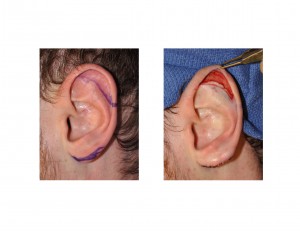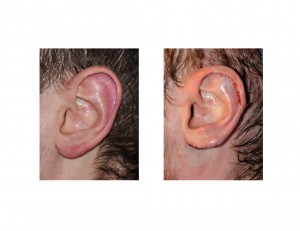Background: Otoplasty is a common aesthetic surgery for ear reshaping which very successfully corrects a protruding ear problem. From incisions behind the ear, a cartilage fold is created by sutures that pulls the helical rim backward reducing its outer prominence and lessening the aurioculomastoid angle. While ears that stick out often look big, they usually only appear that way due to their protrusion.
While protruding ears are very common, a truly large ear or macrotia is very rare. Macrotia would be defined by an ear height that exceeds the normative height of which numerous studies show a mean height of around 60 to 63mms from the apex of the superior helix down to the inferior extension of the lobule. These same studies show that the lobule comprises under 2 cms or less than 1/3 of the total ear height. Morphometric measurements aside, there is also the patient’s perception of whether they think their ear is too long regardless of the actual measurement.
Macrotia reduction surgery is quite different than a traditional setback otoplasty. True vertical ear reduction requires a shortening or removal of skin and cartilage to create that effect. While there are many wedge resection techniques that will create substantial vertical reduction, which are borrowed from skin cancer resection and ear reconstruction technique, they result in a substantial risk of a prominent scar across the central aspect of the ear. While staggering the incisions across the concave and convex surfaces of the ear can help with the scarring substantially, it is still a high risk manuever in the aesthetic ear patient.
Case Study: This 25 year-old young male wanted to decrease the size of his ears. He felt they were too long and disproportionate to the rest of his face. The vertical length of his ears were 71mms. Most of the excessive ear height was in the upper 1/3 of the ear with a large scaphal fossa.


Vertical ear reduction (macrotia reduction) can be successfully done with judicious excisional locations and meticulous surgical technique. Macrotia surgery can be done under local anesthesia with no real recovery other than some ear swelling and mild ear discomfort.
Case Highlights:
1) The large ear, known as macrotia, is most commonly one of increased vertical height.
2) In macrotia reduction surgery, the goal is to place scars at inconspicuous locations as possible. The central wedge reduction method usually results in prominent scarring.
3) Superior scaphal and inferior helical rim reductions can create up to a cm. of vertical height ear shortening with very acceptable scarring.
Dr. Barry Eppley
Indianapolis, Indiana


